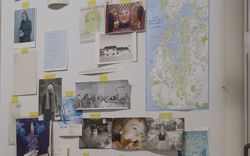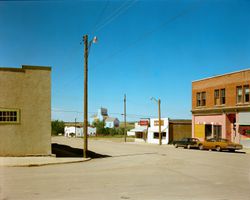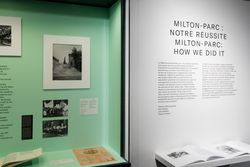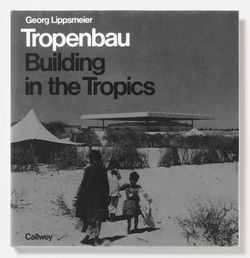articles
Jonas Henderson, Emma Martin, DEW Line, radar, colonial, Distant Early Warning Line, Inuit, indigenous, Nunangat, Yukon
10 December 2022
Colonial Gazing, Part 2: The Silent Attack on Inuit Nunangat
Emma Martin and Jonas Henderson study the DEW Line photographs within the CCA’s collection
Actions:
articles
10 December 2022
articles
Photography as Project
Stefano Graziani; Bas Princen; The Lives of Documents, CCA collection, architecture photography, photography as a project
24 April 2023
This critical reading of exemplary projects from the CCA Collection reveals everyday spatial and power dynamics that have created middlegrounds but that have not often been acknowledged. Beyond restitution, how can architects participate in imagining more just futures for sites of dispossession?
Hall Cases Keyword(s):
Middleground, hall cases, Rafico Ruiz, Louise Paradis, indigenous, sovereignty, Ella den Elzen, Camille Saade-Traboulsi
10 February 2021 to 13 March 2022
Middleground: Siting Dispossession
Actions:
Description:
This critical reading of exemplary projects from the CCA Collection reveals everyday spatial and power dynamics that have created middlegrounds but that have not often been acknowledged. Beyond restitution, how can architects participate in imagining more just futures for sites of dispossession?
Hall Cases Keyword(s):
Middleground, hall cases, Rafico Ruiz, Louise Paradis, indigenous, sovereignty, Ella den Elzen, Camille Saade-Traboulsi
Join us on Thursday 1 August as Ignacio G. Galan explores the activist designs developed within this context by disabled individuals in their own spaces of residence. Through select objects from the CCA Collection Ignacio G. Galán will situate the Center of Independent Living’s transformations of the household in relation to shifting discourses and paradigms of(...)
1 August 2024, 6pm
Research Fellow Seminar: Ignacio G. Galán
Actions:
Description:
Join us on Thursday 1 August as Ignacio G. Galan explores the activist designs developed within this context by disabled individuals in their own spaces of residence. Through select objects from the CCA Collection Ignacio G. Galán will situate the Center of Independent Living’s transformations of the household in relation to shifting discourses and paradigms of(...)
Sub-series
CI001.S2.D4
Description:
The CCA collection includes albums of drawings for some of Charles Rohault de Fleury's most important public architectural projects, built and unbuilt. They provide valuable insight into his design development process, construction techniques, and flexibility regarding building types and styles, as well as illuminating the larger issues of urban planning and the complex interaction between architect, contractor, and entrepreneur in mid-19th century France. The neo-Moorish Hippodrome National (DR1974:0002:017:001-060) - an ephemeral structure constructed of a wood frame with canvas sheathing- was built adjacent to the Place de l'Étoile in 1845 and destroyed in 1856. The documents and drawings in the album provide a highly detailed and complete overview of the project from the study of historical models to contract drawings. Written documentation, including cost estimates, a contract, daily accounts of construction, entrepreneur's accounts, and correspondence with the principal contractor, is particularly revealing of the working procedures on a large commercial project. In 1855 Charles and Auguste Joseph Pellechet constructed the Chambre des Notaires on the newly transformed Place du Chatelet - the intended centre point of Haussmann's 'Nouveau Paris' (1). The CCA album contains primarily transfer lithographed working and contract drawings signed by the entrepreneurs and/or contractors (DR1974:0002:022:001-021). The plans reflect Charles' sensitive integration of iron and masonry construction, which allowed for abundant fenestration on the side facades, while maintaining the traditional aspects of character and solidity required in a prominent urban building. Charles' approach to the design of more utilitarian structures is indicated in his album of competition drawings for a municipal slaughterhouse submitted to the city of Saint-Germain-en-Laye, 1846-1847 (DR1974:0002:023:001-012). His interpretation of the written programme (included in the album) and the resulting design, is strongly influenced by his father's previous slaughterhouse projects, as well as his own for La Villete, 1835-1836 (see DR1974:0002:014:001-104 in Hubert Rohault de Fleury's Public and Urban Architecture (file CI001.S3.D1)). The pared down Neoclassical style of the slaughterhouse is typical of both Charles and Hubert's utilitarian structures. Charles' largest public urban project outside of Paris was for an unexecuted Hôtel de Prefecture (Departement de la Vienne) and Hôtel de Ville for the city of Poitiers, 1859-1860 (DR1974:0002:020:001-050). The project for the Louis XIIIth style Hotel de Prefecture is fairly complete and includes many working drawings, while the Francis Ist style Hotel de Ville is much less developed and consists primarily of unbound sketches and finished drawings. A site plan indicates that Charles intended the Hôtel de Prefecture and Hôtel de Ville to be located nearly opposite each other and connected by a major thoroughfare. The placement of both structures in the western quarter of the city probably reflects an earlier urban renewal plan proposed by the architects Morandiere et Compaing in 1849. The Hôtel de Prefecture (1864-1868) and Hotel de Ville (1869-1876) were eventually built after designs by Antoine Guerinot, in the same style, and on sites close to those proposed by Charles. Drawings and engravings of antique and contemporary theatres, fountains, honorific monuments, and large public projects by other architects are collected in album DR1974:0002:010:001-048 for reference purposes (some of these may have been collected by his father Hubert). (1) David Van Zanten, "Building Paris: Architectural Institutions and the Transformation of the French Capital, 1830-1870" (Cambridge, Eng.: Cambridge University Press, 1994), p. 235 and pp. 233-241 for the development of the Place du Chatelet.
[1840-1860]
Public and Urban Architecture
CI001.S2.D4
Description:
The CCA collection includes albums of drawings for some of Charles Rohault de Fleury's most important public architectural projects, built and unbuilt. They provide valuable insight into his design development process, construction techniques, and flexibility regarding building types and styles, as well as illuminating the larger issues of urban planning and the complex interaction between architect, contractor, and entrepreneur in mid-19th century France. The neo-Moorish Hippodrome National (DR1974:0002:017:001-060) - an ephemeral structure constructed of a wood frame with canvas sheathing- was built adjacent to the Place de l'Étoile in 1845 and destroyed in 1856. The documents and drawings in the album provide a highly detailed and complete overview of the project from the study of historical models to contract drawings. Written documentation, including cost estimates, a contract, daily accounts of construction, entrepreneur's accounts, and correspondence with the principal contractor, is particularly revealing of the working procedures on a large commercial project. In 1855 Charles and Auguste Joseph Pellechet constructed the Chambre des Notaires on the newly transformed Place du Chatelet - the intended centre point of Haussmann's 'Nouveau Paris' (1). The CCA album contains primarily transfer lithographed working and contract drawings signed by the entrepreneurs and/or contractors (DR1974:0002:022:001-021). The plans reflect Charles' sensitive integration of iron and masonry construction, which allowed for abundant fenestration on the side facades, while maintaining the traditional aspects of character and solidity required in a prominent urban building. Charles' approach to the design of more utilitarian structures is indicated in his album of competition drawings for a municipal slaughterhouse submitted to the city of Saint-Germain-en-Laye, 1846-1847 (DR1974:0002:023:001-012). His interpretation of the written programme (included in the album) and the resulting design, is strongly influenced by his father's previous slaughterhouse projects, as well as his own for La Villete, 1835-1836 (see DR1974:0002:014:001-104 in Hubert Rohault de Fleury's Public and Urban Architecture (file CI001.S3.D1)). The pared down Neoclassical style of the slaughterhouse is typical of both Charles and Hubert's utilitarian structures. Charles' largest public urban project outside of Paris was for an unexecuted Hôtel de Prefecture (Departement de la Vienne) and Hôtel de Ville for the city of Poitiers, 1859-1860 (DR1974:0002:020:001-050). The project for the Louis XIIIth style Hotel de Prefecture is fairly complete and includes many working drawings, while the Francis Ist style Hotel de Ville is much less developed and consists primarily of unbound sketches and finished drawings. A site plan indicates that Charles intended the Hôtel de Prefecture and Hôtel de Ville to be located nearly opposite each other and connected by a major thoroughfare. The placement of both structures in the western quarter of the city probably reflects an earlier urban renewal plan proposed by the architects Morandiere et Compaing in 1849. The Hôtel de Prefecture (1864-1868) and Hotel de Ville (1869-1876) were eventually built after designs by Antoine Guerinot, in the same style, and on sites close to those proposed by Charles. Drawings and engravings of antique and contemporary theatres, fountains, honorific monuments, and large public projects by other architects are collected in album DR1974:0002:010:001-048 for reference purposes (some of these may have been collected by his father Hubert). (1) David Van Zanten, "Building Paris: Architectural Institutions and the Transformation of the French Capital, 1830-1870" (Cambridge, Eng.: Cambridge University Press, 1994), p. 235 and pp. 233-241 for the development of the Place du Chatelet.
File 4
[1840-1860]
research
The 2023 edition of the Virtual Fellowship Program invited new directions, readings, and interactions with the photographic works held in our Collection with a view to charting how broader understandings of ‘vision’ may exceed what Vilém Flusser names the ‘technical image.’
March 2023 to April 2023
Virtual Research Fellows 2023
Actions:
Description:
The 2023 edition of the Virtual Fellowship Program invited new directions, readings, and interactions with the photographic works held in our Collection with a view to charting how broader understandings of ‘vision’ may exceed what Vilém Flusser names the ‘technical image.’
research
March 2023 to
April 2023
archives
Level of archival description:
Fonds
PGL architectes fonds
AP014
Synopsis:
Le fonds PGL architectes, 1959 – 1994, témoigne des activités de la firme d’architecture montréalaise, Papineau Gérin-Lajoie Le Blanc architectes, autant que ses sociétés affiliées et firmes remplaçantes. La majorité du fonds comprend des documents qui représentent 70 projets architecturaux, incluant des projets entrepris à travers le Québec, à Ottawa, à de multiples endroits au Nunavut, ainsi que des projets internationaux. Le fonds met en évidence la participation du PGL dans la construction d'infrastructure coloniale au Nunavik et au Nunavut, y compris les travaux sur des écoles associées avec des foyers fédéraux, qui sont reconnus comme faisant partie du système des pensionnats autochtones du Canada. De plus, le fonds documente l’utilisation des panneaux de fibre de verre modulaires employés par PGL. Pour la plupart, les documents dans ce fonds se composent des dessins, des documents photographiques, et des documents textuels. _____________________________________________________________________________________________________________ The PGL architectes fonds, 1959 - 1994, documents the work and activities of the Montréal-based architecture firm, Papineau Gérin-Lajoie Le Blanc architectes, and its successor and affiliate companies. The records within this fonds represent 70 architectural projects undertaken by the firm, which include projects throughout Québec, Ottawa, and various locations in Nunavut, as well as some international projects. The fonds offers evidence of PGL’s participation in the construction of colonial infrastructure in Nunavik and Nunavut, including work on schools that are connected to Federal Hostels which are recognised as part of Canada's Indian Residential School system. The fonds also contains records documenting PGL’s use of modular, fiberglass-reinforced plastic panels in construction. The records within this fonds largely consist of drawings, photographic materials, and textual records.
1959 - 1994
PGL architectes fonds
Actions:
AP014
Synopsis:
Le fonds PGL architectes, 1959 – 1994, témoigne des activités de la firme d’architecture montréalaise, Papineau Gérin-Lajoie Le Blanc architectes, autant que ses sociétés affiliées et firmes remplaçantes. La majorité du fonds comprend des documents qui représentent 70 projets architecturaux, incluant des projets entrepris à travers le Québec, à Ottawa, à de multiples endroits au Nunavut, ainsi que des projets internationaux. Le fonds met en évidence la participation du PGL dans la construction d'infrastructure coloniale au Nunavik et au Nunavut, y compris les travaux sur des écoles associées avec des foyers fédéraux, qui sont reconnus comme faisant partie du système des pensionnats autochtones du Canada. De plus, le fonds documente l’utilisation des panneaux de fibre de verre modulaires employés par PGL. Pour la plupart, les documents dans ce fonds se composent des dessins, des documents photographiques, et des documents textuels. _____________________________________________________________________________________________________________ The PGL architectes fonds, 1959 - 1994, documents the work and activities of the Montréal-based architecture firm, Papineau Gérin-Lajoie Le Blanc architectes, and its successor and affiliate companies. The records within this fonds represent 70 architectural projects undertaken by the firm, which include projects throughout Québec, Ottawa, and various locations in Nunavut, as well as some international projects. The fonds offers evidence of PGL’s participation in the construction of colonial infrastructure in Nunavik and Nunavut, including work on schools that are connected to Federal Hostels which are recognised as part of Canada's Indian Residential School system. The fonds also contains records documenting PGL’s use of modular, fiberglass-reinforced plastic panels in construction. The records within this fonds largely consist of drawings, photographic materials, and textual records.
archives
Level of archival description:
Fonds
1959 - 1994
research
Subventions de recherche Groupe Banque TD dans la collection du CCA : Matthew Allen (Harvard University, Graduate School of Design); Christianna Bonin (Massachusetts Institute of Technology, Department of Architecture); Rui Brochado de Morais e Castro (University of Pennsylvania, PennDesign); Gökhan Kodalak (Cornell University, College of Architecture, Art and Planning);(...)
June 2017 to August 2017
Doctoral Students Program 2017
Actions:
Description:
Subventions de recherche Groupe Banque TD dans la collection du CCA : Matthew Allen (Harvard University, Graduate School of Design); Christianna Bonin (Massachusetts Institute of Technology, Department of Architecture); Rui Brochado de Morais e Castro (University of Pennsylvania, PennDesign); Gökhan Kodalak (Cornell University, College of Architecture, Art and Planning);(...)
research
June 2017 to
August 2017
Subventions de recherche Groupe Banque TD dans la collection du CCA : Matthew Allen (Harvard University, Graduate School of Design); Christianna Bonin (Massachusetts Institute of Technology, Department of Architecture); Rui Brochado de Morais e Castro (University of Pennsylvania, PennDesign); Gökhan Kodalak (Cornell University, College of Architecture, Art and Planning);(...)
June 2017 to August 2017
Master’s Students Program: About Africa
Actions:
Description:
Subventions de recherche Groupe Banque TD dans la collection du CCA : Matthew Allen (Harvard University, Graduate School of Design); Christianna Bonin (Massachusetts Institute of Technology, Department of Architecture); Rui Brochado de Morais e Castro (University of Pennsylvania, PennDesign); Gökhan Kodalak (Cornell University, College of Architecture, Art and Planning);(...)





